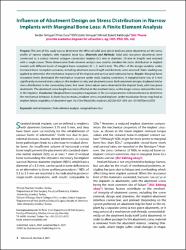Influence of abutment design on stress distribution in narrow implants with marginal bone loss: a finite element analysis
Künye
Yenigun, S., Ercal, P., Ozden-Yenigun, E., & Katiboglu, A. (2021). Influence of Abutment Design on Stress Distribution in Narrow Implants with Marginal Bone Loss: A Finite Element Analysis. The International Journal of Oral & Maxillofacial Implants, 36(4), pp. 640–649. https://doi.org/10.11607/jomi.8554 Özet
Purpose: The aim of this study was to determine the effect of solid (one-piece) and two-piece abutments on the stress profile of narrow implants with marginal bone loss. Materials and Methods: Solid and two-piece abutments were connected to a conical internal octagon-connection implant (3.3 mm in diameter, 10 mm in length) and restored with a single crown. Three-dimensional finite element analysis was used to simulate the stress distribution in implant models with different levels of marginal bone resorption (0, 1, 2, and 3 mm). The effect of the design variables under increased bone resorption scenarios, including abutment screw length and diameter, was assessed. Static loading was applied to determine the mechanical response of the implant and cortical and trabecular bone. Results: Marginal bone resorption levels dominated the mechanical response under static loading conditions. A marginal bone loss of 3 mm significantly increased stress values in the implant vicinity and abutment screw. Both abutment designs displayed similar stress distribution in the surrounding bone, but lower stress values were observed in the implant body with two-piece abutments. The abutment screw length was more effective in the resultant stress, as the longer screws reduced the stress in the implants. Conclusion: Marginal bone resorption magnitude is the crucial parameter in biomechanics to determine the mechanical behavior. As bone loss increases, resultant stress around implants under mastication forces may lead to implant failure, regardless of abutment type.

















